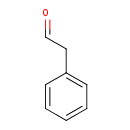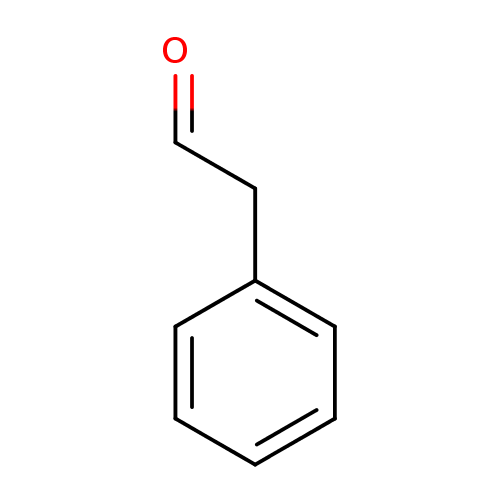|
Record Information |
|---|
| Version |
1.0 |
|---|
| Update Date |
1/22/2018 11:54:54 AM |
|---|
|
Metabolite ID | PAMDB120110 |
|---|
|
Identification |
|---|
| Name: |
phenylacetaldehyde |
|---|
| Description: | An aldehyde that consists of acetaldehyde bearing a methyl substituent; the parent member of the phenylacetaldehyde class of compounds. |
|---|
|
Structure |
|
|---|
| Synonyms: | - 1-Oxo-2-phenylethane
- 2-phenylacetaldehyde
- 2-Phenylethanal
- α-phenylacetaldehyde
- alpha-tolualdehyde
- alpha-Tolualdehyde
- α-tolualdehyde
- α-toluic aldehyde
- Benzacetaldehyde
- Benzeneacetaldehyde
- Hyacinthin
- Phenacetaldehyde
- Phenylacetaldehyde
- PHENYLACETALDEHYDE
- phenylacetaldehyde
- Phenylacetic aldehyde
|
|---|
|
Chemical Formula: |
C8H8O |
|---|
| Average Molecular Weight: |
120.151 |
|---|
| Monoisotopic Molecular
Weight: |
120.05752 |
|---|
| InChI Key: |
DTUQWGWMVIHBKE-UHFFFAOYSA-N |
|---|
| InChI: | InChI=1S/C8H8O/c9-7-6-8-4-2-1-3-5-8/h1-5,7H,6H2 |
|---|
| CAS
number: |
122-78-1 |
|---|
| IUPAC Name: | phenylacetaldehyde |
|---|
|
Traditional IUPAC Name: |
phenylacetaldehyde |
|---|
| SMILES: | [CH](=O)CC1(=CC=CC=C1) |
|---|
|
Chemical Taxonomy |
|---|
|
Taxonomy Description | This compound belongs to the class of chemical entities known as phenylacetaldehydes. These are compounds containing a phenylacetaldehyde moiety, which consists of a phenyl group substituted at the second position by an acetalydehyde. |
|---|
|
Kingdom |
Chemical entities |
|---|
| Super Class | Organic compounds |
|---|
|
Class |
Benzenoids |
|---|
| Sub Class | Benzene and substituted derivatives |
|---|
|
Direct Parent |
Phenylacetaldehydes |
|---|
| Alternative Parents |
|
|---|
| Substituents |
- Phenylacetaldehyde
- Alpha-hydrogen aldehyde
- Organic oxygen compound
- Organic oxide
- Hydrocarbon derivative
- Organooxygen compound
- Carbonyl group
- Aldehyde
- Aromatic homomonocyclic compound
|
|---|
| Molecular Framework |
Aromatic homomonocyclic compounds |
|---|
| External Descriptors |
|
|---|
|
Physical Properties |
|---|
| State: |
Solid |
|---|
| Charge: | 0 |
|---|
|
Melting point: |
120.5 - 121.5 °C |
|---|
| Experimental Properties: |
| Property | Value | Reference |
|---|
| Melting Point | 120.5 - 121.5 °C | Not Available | | Boiling Point | Not Available | Not Available | | Water Solubility | Not Available | Not Available | | LogP | 1.78 | HANSCH,C ET AL. (1995) |
|
|---|
| Predicted Properties |
|
|---|
|
Biological Properties |
|---|
| Cellular Locations: |
Not Available |
|---|
| Reactions: | |
|---|
|
Pathways: |
Not Available |
|---|
|
Spectra |
|---|
| Spectra: |
| Spectrum Type | Description | Splash Key | |
|---|
| GC-MS | GC-MS Spectrum - GC-MS | splash10-00kf-9400000000-bec6e42b47ad1306960f | View in MoNA |
|---|
| GC-MS | GC-MS Spectrum - GC-MS | splash10-014l-9700000000-152bdd5b77d6af9657ec | View in MoNA |
|---|
| Predicted GC-MS | Predicted GC-MS Spectrum - GC-MS | Not Available |
|---|
| LC-MS/MS | LC-MS/MS Spectrum - Quattro_QQQ 10V, Positive (Annotated) | splash10-0udi-4900000000-5001b07cef2fed3caa2c | View in MoNA |
|---|
| LC-MS/MS | LC-MS/MS Spectrum - Quattro_QQQ 25V, Positive (Annotated) | splash10-004i-9100000000-048e2f1b42f7bd5104be | View in MoNA |
|---|
| LC-MS/MS | LC-MS/MS Spectrum - Quattro_QQQ 40V, Positive (Annotated) | splash10-0fb9-9000000000-fc1fbd4e7c49f44ba764 | View in MoNA |
|---|
| LC-MS/MS | LC-MS/MS Spectrum - EI-B (HITACHI M-80A) , Positive | splash10-0006-9000000000-bc0fa2967da6872f3a47 | View in MoNA |
|---|
| Predicted LC-MS/MS | Predicted LC-MS/MS Spectrum - 10V, Positive | splash10-00di-0900000000-8c96fee71b311d751181 | View in MoNA |
|---|
| Predicted LC-MS/MS | Predicted LC-MS/MS Spectrum - 20V, Positive | splash10-0fk9-2900000000-4b405668c302f69a4bc7 | View in MoNA |
|---|
| Predicted LC-MS/MS | Predicted LC-MS/MS Spectrum - 40V, Positive | splash10-0ufr-9300000000-fe46a418a2f0124566c3 | View in MoNA |
|---|
| Predicted LC-MS/MS | Predicted LC-MS/MS Spectrum - 10V, Negative | splash10-014i-0900000000-4e064e0123dc18b6136a | View in MoNA |
|---|
| Predicted LC-MS/MS | Predicted LC-MS/MS Spectrum - 20V, Negative | splash10-014i-1900000000-02fff0bd874e6e8616bb | View in MoNA |
|---|
| Predicted LC-MS/MS | Predicted LC-MS/MS Spectrum - 40V, Negative | splash10-004l-9200000000-340c7a60a7708fa801f1 | View in MoNA |
|---|
| MS | Mass Spectrum (Electron Ionization) | splash10-0006-9100000000-e7ef9a5c5a6cc5674cd1 | View in MoNA |
|---|
|
|---|
|
References |
|---|
| References: |
- Ockey DA, Gadek TR (2004)Discovery of novel PTP1b inhibitors. Bioorganic & medicinal chemistry letters 14, Pubmed: 14698165
- Hoet S, Stévigny C, Hérent MF, Quetin-Leclercq J (2006)Antitrypanosomal compounds from the leaf essential oil of Strychnos spinosa. Planta medica 72, Pubmed: 16557466
- Amar-Zrihen N, Aserin A, Garti N (2011)Food volatile compounds facilitating HII mesophase formation: solubilization and stability. Journal of agricultural and food chemistry 59, Pubmed: 21495722
- Chu FL, Yaylayan VA (2008)Model studies on the oxygen-induced formation of benzaldehyde from phenylacetaldehyde using pyrolysis GC-MS and FTIR. Journal of agricultural and food chemistry 56, Pubmed: 18954073
- San-Juan F, Ferreira V, Cacho J, Escudero A (2011)Quality and aromatic sensory descriptors (mainly fresh and dry fruit character) of Spanish red wines can be predicted from their aroma-active chemical composition. Journal of agricultural and food chemistry 59, Pubmed: 21627324
|
|---|
| Synthesis Reference: |
Sun Zhirong; Hu Xiang; Zhou Ding Wastewater minimization in indirect electrochemical synthesis of phenylacetaldehyde. TheScientificWorldJournal (2002), 2 48-52. |
|---|
| Material Safety Data Sheet (MSDS) |
Download (PDF) |
|---|
|
Links |
|---|
| External Links: |
|
|---|


